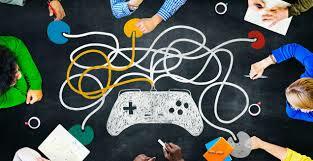Polina Korchagina’s Updates
Update 4 Bookwidgets Games
When we hear about gamification in education, we usually think about playing games during lessons. But gamification is much more than just games, and its application is much wider than just entertaining students.
Gamification became an integral part of almost every field of our lives. Marketing and advertisement use gamification the most nowadays: companies employ game elements to make people buy and use their products, social networks employ game elements to keep people online for hours.
The main benefit, pointed out by many scholars is increased students' motivation. Studies show, that gamification facilitates learning by encouraging user engagement, problem solving and out of the box thinking.
Also, some researches showed that gamification eases stress and fear of failing. This is especially beneficial for students who have test anxiety: when they perceive the test as a game or a quest, their anxiety decreases.
Gamification provides students with opportunity to experience a real-life situation, apply their skills in real-world scenarios. Students get a first hand experience in the field they are going to work in.
Gamification enhances learning experience, by adding new elements to the traditional methods and approaches. Games can employ visual, audio and other sensory content to make the learning experience more satisfying and efficient. This benefit will be especially useful for students whose styles of learning doesn't fit traditional presentation of information. For example, students with kinesthetic style of learning have difficulty adjusting to traditional language lessons, which employ mostly visual and auditory channels of processing information. Kinesthetic students will benefit from gamifcated tasks using augmented reality or virtual reality.
Knowing that, teachers can create a task or an activity, aimed at certain learning style.
Gamification is different from Game-based Learning (GBL). Game-based Learning uses actual games to teach something. Through the games students acquire a specific skills or gain knowledge.
Gamification applies the rules of a game to a task or lesson, making it seem less like a game but employing the same principles.
Games are very popular in the field of language learning.
One of the games I use in my classes every day is Bookwidgets games.
Bookwidgets is an interactive learning platform, that can be used to create different activities for the classroom.
The following video explains what is bookwidgets:
Bookwidgets offers different games and activities including puzzles, crosswords, bingo and many others.
Here you can see how to create a memory game:
These games, when integrated in the lessons, help students get a break from textbooks, boosts their motivation and help retain material through fun activities. They also promote autonomy – as students solve problems, complete tasks and follow the path to the mastery individually or in teams. Bookwidgets help teachers keep students engaged and motivated.



So nice! I will try GeoGuessr